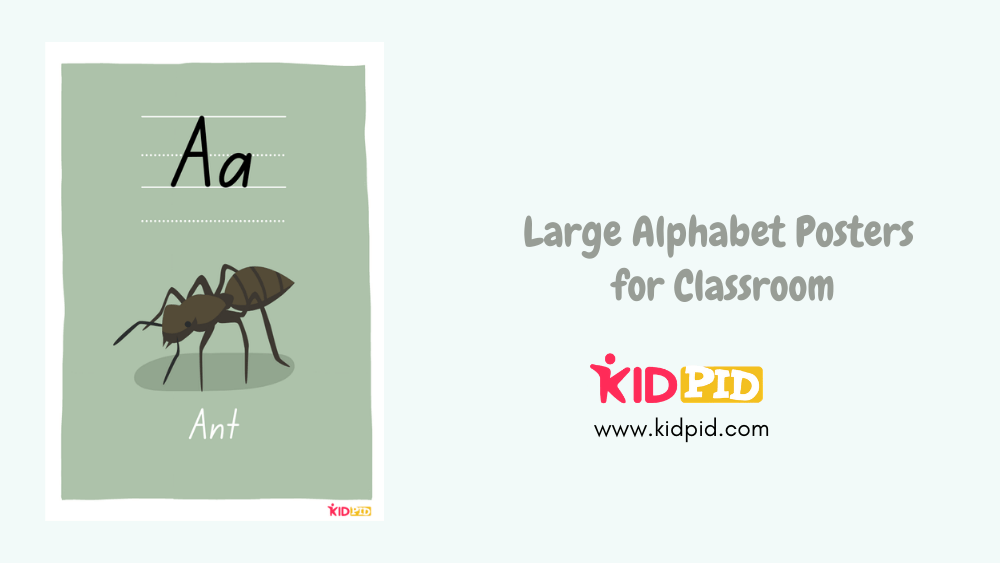Alphabets are the building blocks of words. Each word that we write in any sentence, essay, short story, poetry, or anything else is made up of several letters joined with each other. It is why alphabets are the first thing any preschooler is taught. The following posters can be used in the classroom for kids to identify each of the 26 alphabets. Along with the alphabets, our poster also includes a picture and name of the animal which starts with the letter.
[Scroll Down for Download Link]
Alphabet Posters For Classroom
A is for ants. Ants are insects that can lift 20 times their own bodyweight! There are more than 12,000 species of ants all over the world.
# B spells Bilby. Bilbies are endangered animals found only in Australia. It is about the size of a domestic cat. Aboriginal Australians hunted Bilbies for food and their skins.
# C stands for Cockatoo. Often referred to as “velcro” birds, Cockatoos are fun-loving parrots that stand out from parrots with their dusty feathers and varying shades of pink, gray, white, and black.
# D is for Dingo. Dingo’s are medium-sized canines that possess a lean, hardy body that is adapted for speed, agility, and stamina. Dingo’s are native to Australia.
Echidna is spelled with E. Echidnas are egg-laying mammals often referred to as spiny anteaters. They are characterized by their beady eyes, tiny mouth, and two small nostrils at the end of their beaks.
F is for the frog. Frogs belong to a carnivorous group of short-bodied amphibians. These are aquatic amphibians that have slender bodies with smooth moist skin and strong long hind legs with webbed feet.
Goannas are large lizards mostly native to Australia. Also known as Monitors, Goannas are a very distinctive group of lizards that evolved in the northern hemisphere.
Huntsman Spider is one of several species of spiders. These are long-legged predators that hunt their prey. Characterized sometimes by their banded legs, they are mostly grey to brown in color.
I spells Ibis. Ibis are a group of long-legged birds that inhabit wetlands, forests, and plains. They have long bills and usually feed as a group.
Jellyfish are free-swimming marine animals characterized by their umbrella-shaped bells and tentacles. An interesting fact regarding Jellyfish is that despite their name these are not fish. Moreover, they don’t have brains, eyes, or hearts!
K stands for Kangaroo. Kangaroos are mammals found in Australia. They have pouches in which they carry their young ones.
Lyrebirds is spelled with L. Lyrebirds. These are large birds notable for their ability to mimic natural and artificial sounds from their environment.
M stands for Magpie. Magpies are long-tailed crows with green plumage and a noisy call. These are considered to be intelligent creatures.
Numbats are small termite-eating Australian animals with a black and white striped back and a bushy tail.
Orcas or killer whales are large-toothed whales characterized by their black body with a white underside and patches near each eye.
Platypus is a semiaquatic, egg-laying mammal also known as duckbill. It is noted for its combination of primitive features.
Quokka or short-tailed scrub wallaby as it is known otherwise is a small animal about the size of a domestic cat.
Native to southeast Australia, Rosellas are birds capable of loud chatter. They are extremely desirable as pets.
Sugar Gliders are small nocturnal gliding animals. These are similar to the size of squirrels and inhibit the forests of Australia and New Guniea.
Tasmanian Devil is the world’s largest carnivorous marsupial.
Urchins or Sea Urchins are spiny animals that inhabit oceans.
Velvet Gecko is a species of large lizards found exclusively in Southern Africa.
Wombats are native to Australia. These are short-legged nocturnal animals known for their digging abilities.
Xenicus are birds more popularly known as New Zealand Wrens.
Yabbies are small freshwater crayfishes. Fishing for yabbies is a common sport in Australia.
Zebra Finch is a tiny finch that gets its name from the zebra-like stripes across its neck and chest. Found commonly in Australia it ranges all over the continent.
Read More:
